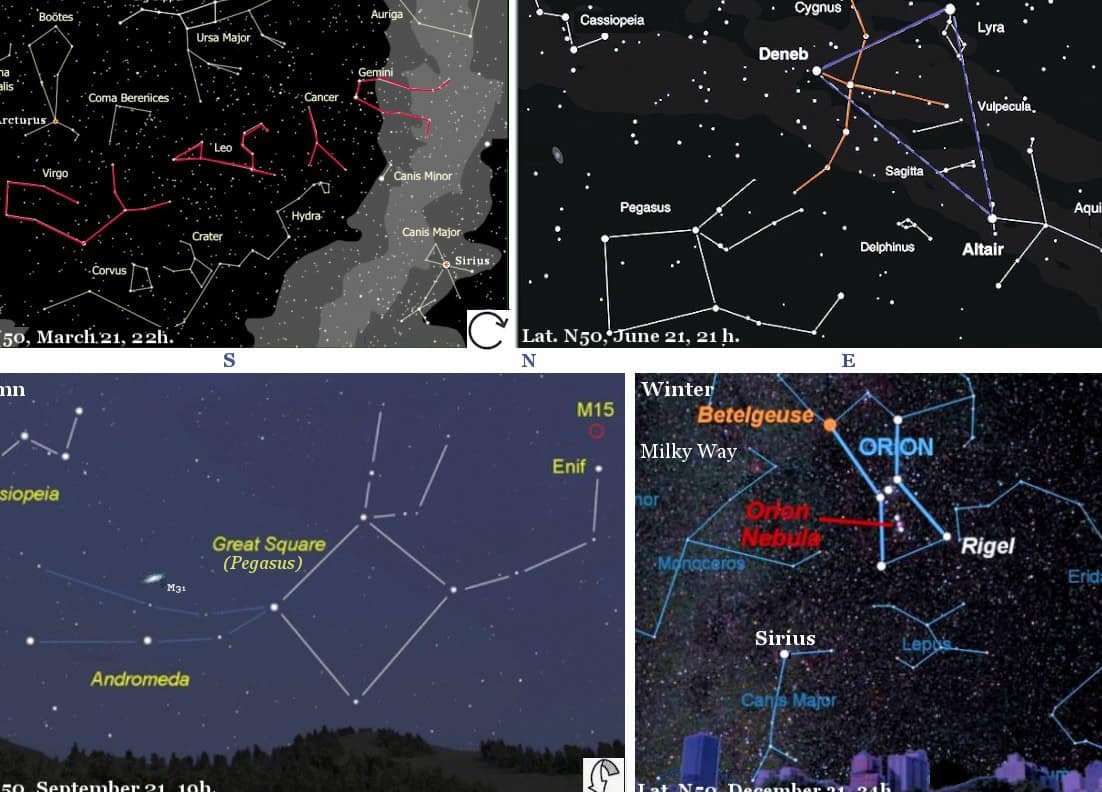Nevertheless, there exist regions in Russia where one can witness the presence of the Milky Way and stars with a magnitude of 6. To successfully observe these celestial bodies, it is recommended to venture at least 20-30 km from urban areas.
The Celestial Expanse

When you gaze up at the night sky, a multitude of brilliant lights will greet your eyes. These luminous points are known as stars, which can be observed either on their own or in clusters called constellations. Among them, the nearest and most radiant star is the Sun. Now, let’s delve into an intriguing subject – the “Starry Sky” (for 3rd graders).
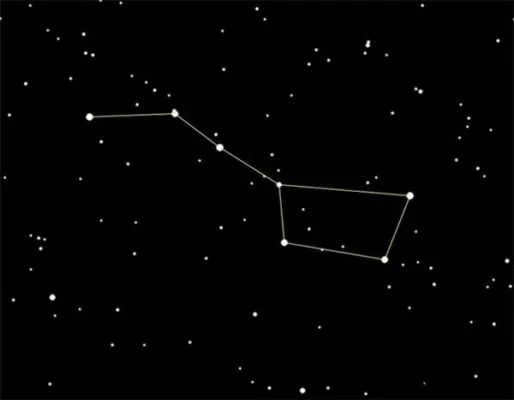
The collaboration with Akulinkina Tatiana Nikolaevna, a teacher of the highest category, resulted in the creation of this material.
The emergence of celestial bodies
The branch of science that focuses on the exploration of celestial bodies is known as astronomy. The term “aster” in Greek translates to star. Astronomers examine stars using an advanced and highly potent device called a telescope.
A star represents a celestial entity composed of luminous gas. Stars are generated in outer space from the accumulation of interstellar gas. The mass gradually starts rotating at an extremely high velocity and eventually expands in size exponentially. Within it, the temperature reaches astonishing levels, several million degrees Celsius, causing it to emit light – thus, a new star is born.
The Sun, our nearest star, is significantly larger than the Earth. Due to its intense luminosity, we are unable to observe other stars during daylight hours, as they are located at a greater distance and emit less radiant light. Interestingly, there are stars within our galaxy that emit light several magnitudes stronger than the Sun; however, their distance from Earth is quite substantial.
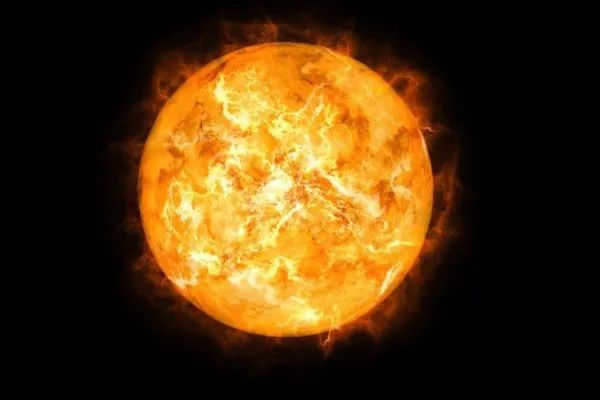
Upon initial observation, it may appear that all stars possess the same hue – white. However, this assumption is not entirely accurate. Blue stars, in fact, are the most scorching and luminous, followed by stars of white, yellow, and orange tints. The lower the surface temperature of a star, the more it tends to exhibit a reddish complexion.
Star Groups in the Milky Way
Within the vast expanse of the Milky Way, there exist various clusters of stars that come together to form unique constellations. These celestial formations originate from a shared cloud of dust and gas, and are bound together by the force of mutual gravitational attraction.
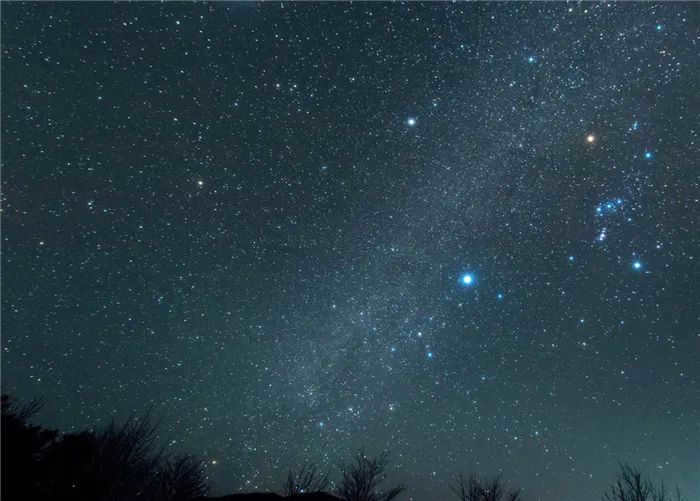
Star clusters are predominantly found along the expanse of the Milky Way. There have been over a thousand of these star clusters tallied by scientists, yet inevitably they all disassemble.
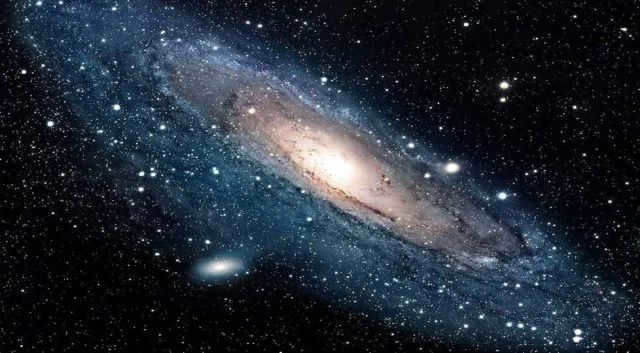
The arrangement of the stars in the sky remains constant. In ancient times, people observed the most prominent constellations and gave them names inspired by mythical creatures, folklore, and legendary figures.
In 1930, the International Astronomical Union officially recognized 88 constellations. They are categorized into three groups based on their location:
- There are a total of 31 constellations in the northern hemisphere.
- The southern hemisphere has a total of 48 constellations.
- There are 9 constellations that can be seen in both hemispheres.
Stars Clusters
In spite of the random arrangement of stars in the celestial sphere, we tend to mentally connect them with various formations such as triangles, chains, and squares. But why? To navigate through the vast expanse of the night sky, it helps to recognize the prominent stars!
For this purpose, ancient civilizations divided the celestial sphere into clusters of stars known as constellations. By connecting the dots of familiar shapes, both real and mythical, they created recognizable patterns. Hence, we have the well-known constellations like the Big Dipper and Orion the Hunter, as well as Leo and Scorpius, among many others.


In the vast expanse of the autumn night sky, every inch is marked by constellations. In total, there are 88 constellations in both the northern and southern hemispheres.
Today, constellations are distinct regions of the sky. There are 88 constellations in total, each with its own unique shape. Some constellations, such as the Big Dipper, consist of a single memorable shape, while others, like Orion, are made up of multiple distinctive patterns. These well-known star shapes, also referred to as patterns or designs, are now recognized as constellations.
Observing the Celestial Canopy
Nevertheless, the aspect of the nocturnal heavens is never stagnant. The starry expanse is in perpetual motion, revolving from the eastern to the western horizon. The celestial dome possesses an axis of rotation that aligns with the celestial poles – the northern and southern extremities. Polaris, also known as the North Star, is positioned near the northern celestial pole and is renowned for its nearly motionless state. Meanwhile, all the other stars orbit around Polaris and trace circular paths across the firmament on a daily basis. The size of these loops corresponds to the distance of each luminary from Polaris. (Observe the daily trajectory of the stars).
The configuration of the night sky is influenced by the hour of the day and the season of the year
When the axis of the celestial sphere leans towards the horizon, the starry sky appears to revolve, slightly off-kilter. As a consequence, various constellations, like the Sun and Moon, emerge in the east, ascend higher above the horizon in the south, and sink in the west. This explains why we observe one constellation in the evening and an entirely distinct constellation in the morning.
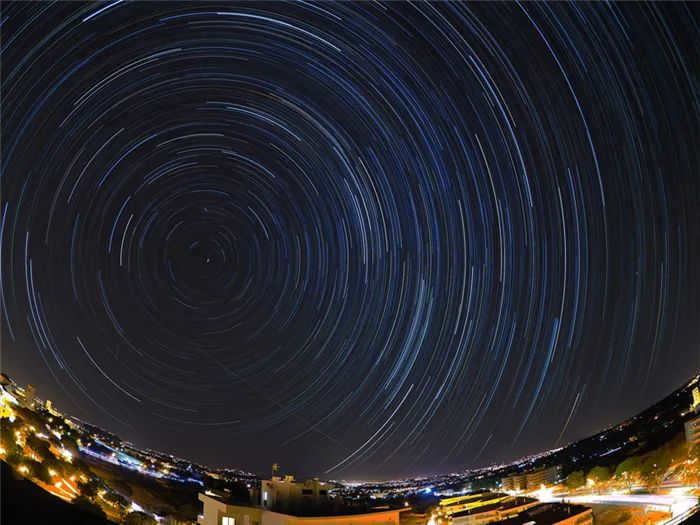
Long exposure photographs of the nighttime sky demonstrate the daily movement of the stars. As the stars traverse the sky, they create arcs that grow longer the further they move from the celestial pole. In a single day, the celestial sphere completes one full rotation. The arcs are more pronounced for stars located at the celestial equator. This pattern is a result of the Earth’s rotation on its axis. Photo.
The appearance of the starry sky is influenced by both the time of day and the season. The Earth’s orbit around the Sun causes different constellations to come into view at different times throughout the year. This means that certain constellations can only be observed during specific seasons. For instance, the constellation Orion is visible during the winter months but completely invisible during the first half of summer (it can only be seen in the daytime sky!). On the other hand, the constellation Sagittarius is visible during the summer but cannot be seen at all during the winter.
The observation of the starry sky is influenced by the latitude
The latitude of the viewing location plays a significant role in determining the view of the night sky. When observing from Earth’s north pole, Polaris can be seen at its zenith, and only the northern hemisphere of the celestial sphere is visible. However, as we move south, Polaris gradually descends in the sky, allowing not only the stars in the northern hemisphere but also some stars in the southern hemisphere to come into our view. Ultimately, at the Earth’s equator, all 88 constellations can be observed throughout the year!

Only the most prominent celestial bodies, such as the moon, planets, and the brightest stars, are visible in the night sky of major cities. Photo.
The overwhelming brightness of urban areas has prompted avid astronomers to seek out locations with minimal light pollution for their astronomical observations. To locate these ideal spots, one can refer to specialized light pollution maps.
However, it is also possible to begin studying the starry sky within the city limits. Look for a secluded spot shielded from the direct glare of streetlights and car headlights. This could be on the outskirts of town, in a park, on a beach, or along a riverbank. Alternatively, if you reside at a sufficient height and are not obstructed by neighboring buildings, you can also observe the nighttime sky from your balcony.
You know, my friends and I were also curious last year about how the constellations are represented by their names in the sky. We pondered and pondered and pondered.
And then we decided to try LSD and suddenly everything made sense))))))
Reply to the post “Lights in a closed building.”
Being high school students, one night my friends and I explored the debris in the ventilation system of an underground bomb shelter (I’m not sure if that’s the correct term, but everyone has seen those concrete structures in yards) and squeezed through a narrow opening to enter the building.
The bomb shelter was located beneath a house that was currently undergoing extensive remodeling. Surrounding the property was a sturdy fence, with the entrance doors securely locked and a vigilant watchman stationed nearby. Despite these precautions, we managed to surreptitiously access the bomb shelter from the street, intermittently and discreetly. Inside, we would casually gather, indulging in the rebellious pleasures of beer drinking and cigarette smoking, relishing in the illusion of our maturity and sophistication. Ah, the audacity of youth.
One day, we made an exciting discovery that the door connecting the shelter and the house could be opened discreetly from the shelter’s side. This enabled us to enter the house without anyone noticing. During weekends and late evenings, we would venture into the sealed house and engage in a variety of peculiar activities. We would turn objects upside down, rearrange them, and even relocate the builders’ tools and belongings into the bomb shelter, only to return them to their original places a few days later. Essentially, we were playing the role of mischievous poltergeists. Fortunately, security cameras were not in use during those times.
Regardless, we were having a great time. Then, one day, we witnessed the workers congregating at the entrance while a vehicle pulled up, carrying two individuals dressed in black robes. They removed a casket from the car and entered the house. The onlookers stood in tense silence, while we stifled our laughter around the corner. Meanwhile, the elderly women gathered outside the store across the street whispered about sinister forces at play.
From that moment on, we still ventured into the bomb shelter, but we never dared to enter the house again.


The backpack I purchased from the military store has sparked numerous questions but provided very few answers. When I washed the lining, I discovered three tiny capsule wrappers containing notes. I reached out to all my social media networks, asking friends and acquaintances if they knew the language on the notes or what was written on them, but unfortunately, no one could provide an answer. If you have any knowledge about the language, please share in the comments. I’m incredibly curious and eager to learn more. It’s such a captivating mystery, I can’t even focus on eating. The story behind these notes is truly strange and fascinating.

Can one truly lose oneself? The Tale of Lawrence Bader
My usual focus lies on unresolved vanishings, but this instance presents a different twist. The individual in question, previously missing, has resurfaced unharmed, leaving us with a plethora of inquiries regarding his ordeal.

Lorrie Badder was employed as a sales representative for a company that sold household appliances. He was married to Mary Lou and they had three children together.
In the spring of 1957, Lorrie and Mary Lou were anticipating the arrival of their fourth child. Their life seemed perfect and Lorrie appeared to be content. However, one day, Lawrence suddenly vanished….
Badder went missing during a fishing trip on Lake Airy. Since he had gone to the lake alone, the Coast Guard speculated that he may have drowned.

On March 15, 1957, Larry decided to head to the lake after a business meeting. Being an avid fisherman, it came as no surprise to anyone that he chose to spend his free time fishing.
The previous day, Lawrence had discussed the worsening weather with his wife, Mary Lou. She had advised him to cancel the trip, but he didn’t give any specific response.
As Lawrence didn’t own a boat, he rented one for the day. The boat owner, aware of the weather conditions, cautioned him and even offered an extra life jacket, but Lawrence declined.
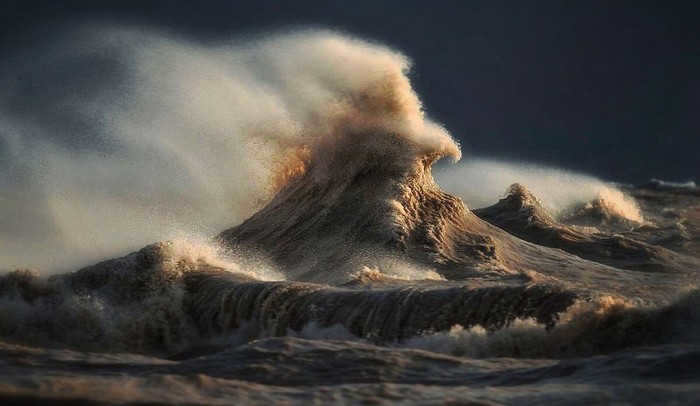
The man was also spotted by the Coast Guard on the lake that day. They approached Bader and offered to take him back to shore, but he declined. He mentioned that he had a favorite spot nearby and insisted on going there.
Mary Lou, Bader’s wife, grew concerned and contacted the coast guard while waiting for her husband at home. Unfortunately, they couldn’t assist her as there was a storm approaching. The search for Bader was postponed, leaving the anxious woman with no choice but to wait.
Later on, the Coast Guard discovered a drifting boat in the same vicinity, but Bader was nowhere to be found. In addition to himself, his life jacket and a small suitcase were also missing. The boat itself remained undamaged.
It strikes me as rather peculiar that the Coastal Service came to the conclusion that Bader had no valid reason to vanish. Isn’t that the type of determination typically made by the police during an investigation?
Lawrence was heavily burdened by debt and was making payments on a $20,000 mortgage. He had neglected to pay his taxes for six years – since 1951, and this could have resulted in possible imprisonment. The family’s income was below average, and his wife was pregnant and unable to work. On the day he went missing, Bader cashed a $400 check. That was a significant amount of money for that time period.
However, despite Bader having substantial insurance coverage that would provide a sizable payout to his family in the event of his demise, his disappearance was officially deemed an accident.
In 1960, Mary Lou received a $40,000 insurance payout, three years after her husband vanished. This substantial sum of money likely resolved all the financial difficulties the family faced, including the mortgage and any outstanding debts owed by Mr. Badder.

Lawrence had been presumed dead for approximately eight years, but a single event changed everything.
A companion of Bader’s appeared at a sports equipment exhibition in Chicago. And who did he come across? Lawrence Bader himself, in the flesh.
The man was employed at one of the archery booths. Despite sporting an eye patch and a thin mustache, he bore a striking resemblance to the late Lawrence Bader.
Upon seeing his friend, the man did not react and introduced himself as John F. “Fritz” Johnson. A close associate of the deceased discovered that Johnson originally hailed from Omaha, Nebraska, where he had achieved fame as a television personality.
The acquaintance of the deceased reached out to John Bader, the brother of Bader, informing him about the individual he encountered. Initially, John Bader was doubtful but still requested his niece to visit the exhibit and witness the man herself. Coincidentally, the young woman resided in Chicago.
Susanna, the aforementioned niece, couldn’t believe what she saw. Standing before her was Lawrence Bader, with the exception of an eye patch, the man appeared unscathed.
Fritz himself failed to recognize any of the individuals in the narrative and disavowed any association with Bader. Despite this, Susanne somehow managed to convince the man to contact his brothers, John and Richard. Upon hearing the man’s voice and identifying him as their father, both brothers promptly made arrangements to travel to Chicago.
Mary Lou, Lawrence’s spouse, declined to accompany them. The reasons behind her decision remain unknown to us.

Fritz Johnson appeared to find the entire situation quite entertaining. He insisted that he was a well-known figure in Columbus, regularly making appearances on television and radio.
He even consented to having his fingerprints taken and compared to those of the missing Lawrence Bader. The fact that he readily agreed to this suggested that there was no possibility of him being the missing individual.
To Fritz’s astonishment, his fingerprints matched those of the missing Bader. This piqued the interest of the press. Under the watchful eye of the media and the public, the fingerprints were sent to the FBI for an independent analysis.
Following an extensive investigation, the case involving insurance payoffs and the falsification of death was thoroughly examined.
It was discovered that the only known information about Johnson was his appearance in Omaha, Nebraska in 1957. The individual claimed to have served in the Navy but retired due to injuries sustained.
Approximately one week after disappearing in Lake Airy, the man reappeared in Omaha, Nebraska. He introduced himself as John F. Johnson but preferred to be called “Fritz.”
He informed others that he was an orphan who grew up in an orphanage and served as a war veteran. The man had served in the U.S. Navy and retired following a significant injury.
Soon enough, the man gained popularity in Omaha. His laid-back speaking style and quirky personality helped him secure a job at a popular bar and as a radio disc jockey at one of the city’s stations.
The man had always lived his life as a dedicated bachelor, indulging in parties, drinking, and engaging in wild antics.
But in 1961, everything changed when he decided to marry Nancy Zimmer, a divorced woman (which was considered shameful and disgraceful at that time), who was only 21 years old. To everyone’s surprise, Fritz even took on the responsibility of raising her child, and before long, the couple welcomed a daughter of their own.

This individual gained considerable recognition and quickly secured a position as the sports director at a local television station. It was a stroke of good fortune for an ordinary individual.
In 1964, he fell ill and sought medical attention. It was discovered that he had developed a malignant tumor behind one of his eyes, which would later necessitate its removal.
However, even in this situation, Fritz remained undeterred and enhanced his already eccentric appearance by wearing an eye patch and sporting a thin mustache. He resembled a genuine pirate.
Archery was the sole hobby that linked him with Larry Bader. As a resident of Omaha named Fritz, he actively participated in both city and national archery competitions. Johnson was honored with numerous prestigious accolades, eventually transitioning into a professional athlete.

Fritz’s popularity and athletic achievements led him to the Chicago exhibition. The Sanders Archery Company approached Johnson to be their representative at the event. This is when the truth was uncovered.
Once forensic experts identified Fritz Johnson and Lawrence Bader as one and the same person, his life turned into a nightmare.
The news spread nationwide, with doctors speculating whether Bader may have experienced amnesia. Mary Lou was shocked to realize she was no longer a widow. Nancy Johnson, his current wife, declined to comment on the situation but later filed for divorce.
From his earnings, he had to allocate funds for alimony payments to both of his ex-wives. Unlike Nancy, Mary Lou made efforts to reconcile with her husband. She made multiple attempts to bring their children to him, but he couldn’t recall any of them.
Subsequently, Johnson underwent extensive testing. Psychiatrists conducted a thorough examination, even resorting to hypnosis. The conclusion was that Johnson’s memory loss was genuine; he truly couldn’t remember anything from his past life.
Ironically, this was the only positive outcome for the unfortunate man, who was facing accusations of insurance fraud and bigamy.
Later, he gave an emotionally charged interview to a journalist from his hometown of Akron, during which he affirmed that he vividly recalled his entire life as Fritz Johnson. He staunchly believed that his memories were authentic and not fabricated in any way.
He was reluctant to return to his hometown. Fritz was concerned that he would once again be examined, interrogated, and generally treated as a lunatic. The man desired to avoid drawing attention to himself.
In May 1966, just a few months after the shocking discovery, Fritz Johnson fell ill. Physicians diagnosed him with stage 4 liver cancer, and the prognosis was discouraging.
On September 16, 1966, he passed away at St. Joseph’s Hospital. He was merely 39 years old. A memorial service was held in his honor.
His body was transported to Akron for burial in the family plot at the Exaltation of the Cross Cemetery.
An Akron newspaper published an epitaph which stated: “It is finished. The man who could not recollect his past will have no future. Only an enigma remains.”.
Throughout history, there have been numerous instances of amnesia, but the case we are about to discuss is particularly notable. It is widely speculated that the individual in question experienced dissociative fugue, a condition that leads to temporary memory loss, or perhaps even schizophrenia, which could have resulted in a split personality.
Considering the eccentric nature of Fritz Johnson, it is quite possible that he was afflicted by a mental disorder that could have triggered his amnesia.

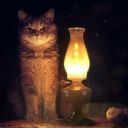
"He sits proudly in the breeze. "(с)
Our village bears a striking resemblance to Lancre. There may not be any witches apart from myself, but if there are any flat surfaces, they are mostly vertical. Our landscape is filled with hills and valleys. When we first arrived to claim our inherited plot, we discovered that we could transform the cottage into a hidden retreat. No matter how large the houses may be in the lowlands, from the road all you can see is a grassy hill at human height. We arrived during the spring season, when everything had already grown and the neighbors had not yet mowed the path. We are grateful to a nearby friend who guided us over the phone through the bushes.
We mowed the path, but it didn’t improve our vision. Eventually, tired of constantly losing our way, our respected matriarch came to a decision: “we need to hang the flag!” At that time, we had Armenians working for us. They were wonderful individuals, and we had been friends for nearly two decades. Somehow, it seemed fitting to hang the Armenian flag. We obtained the flag and securely fastened it to a pole – it looks magnificent! It is easily visible from the road, and now we can jokingly refer to our humble abode as an Embassy, and our slightly overgrown land as a Sovereign Territory. We all shared a good laugh and carried on with our daily lives. One evening, we suddenly heard a commotion coming from the road. Well, noise is noise, regardless of who is making it. The next morning, as I was riding my bicycle, I noticed our flag lying on the ground. Along with the tall and heavy pole. There was no wind, and it was clear that the flag had not fallen on its own, but had been intentionally toppled. Unlike me, the matriarch has spent twenty years living in villages. She immediately assumed the worst – someone did not appreciate our flag. Perhaps they even forbade its display. Or maybe they planned to take it down today, burn it tomorrow, and so on. She said it had happened before. Well, we decided to let it lie there. One day passed, then two days, and still the flag remained on the ground. On the third day, as I was driving, I spotted the Armenian flag proudly waving over the hills of Ryazan. It even had a piece of wood reinforcing it at the bottom.
Take a look at this stunning image of a red currant. There is truly nothing more captivating than the sight of red currants glistening in the warm sunlight.
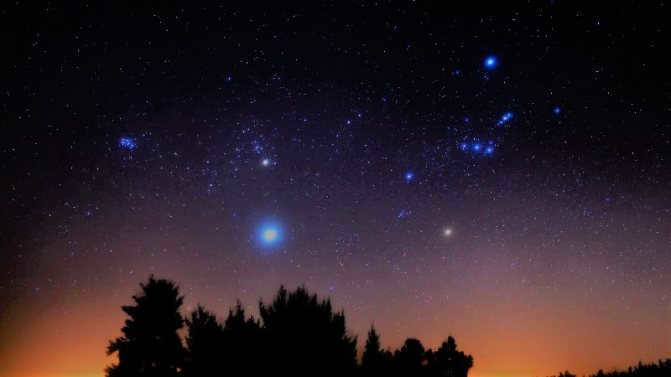

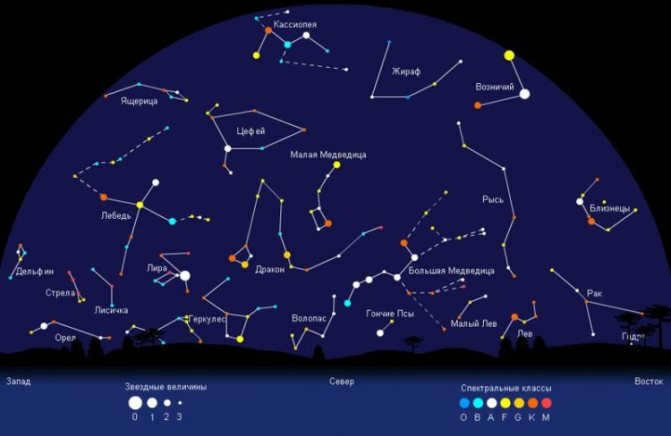

To locate Polaris accurately, a simple method is to use the celestial stars. Polaris, also known as the North Star, is one of the brightest stars in the sky and remains in a fixed position. There are two well-known techniques that can aid in finding Polaris with precision.
The configuration of the Ursa Major and Ursa Minor
These groupings of stars are symbolized by a large and small ladle. To ascertain the primary reference point using the stars, you must follow these steps:
- Visually connect the outermost stars of the Ursa Major’s wall;
- Extend the imaginary line to the furthest star on the handle of the Ursa Minor’s ladle;
- If the distance between the constellations is equal to five times the size of the Ursa Major’s wall, then the reference point is accurately determined.
By observing Polaris, an individual will always head north, consequently, the south will be behind them.
Cassiopeia
During the nighttime hours, it is quite easy to observe the celestial formation known as Cassiopeia, which is represented by the letter W. To locate the North Star, simply follow the line that connects the lower left point of the W shape and the second star on the handle of the Big Dipper. Along this line, you will find the North Star positioned roughly in the middle, where it intersects with the constellation Ursa Minor, also known as the Little Bear.
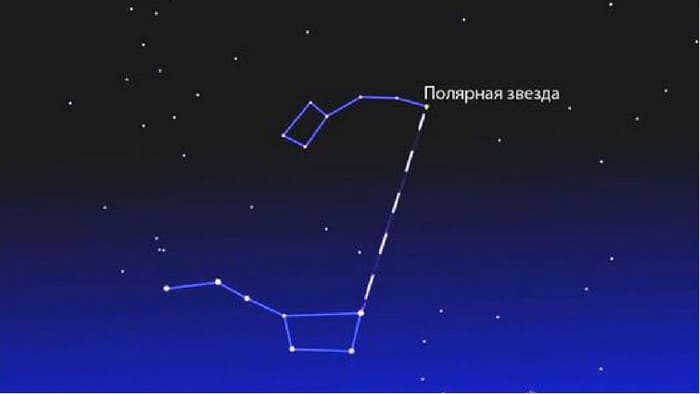
The Big and Little Bears Constellation
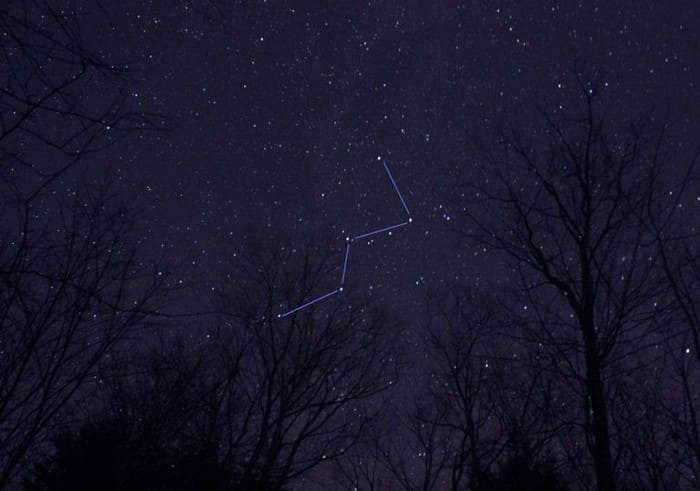
Cassiopeia
Description of fascinating constellations in the Northern Hemisphere
Andromeda
Andromeda is a constellation in the northern hemisphere that is made up of three bright stars arranged in a straight line. The star Alamac is a triple system that consists of a main star that is yellow in color and has a brightness of 2m, as well as two companion stars that are bluish in color. The star Alferatz (also known as Alpharetz) has an Arabic name meaning “Sirrah ap’Faras,” which translates to “the navel of the horse.” Both of these stars are used by sailors as navigational guides when they are at sea. The third star in the constellation is Mirach, which is located between the other two stars.
The Great Bear
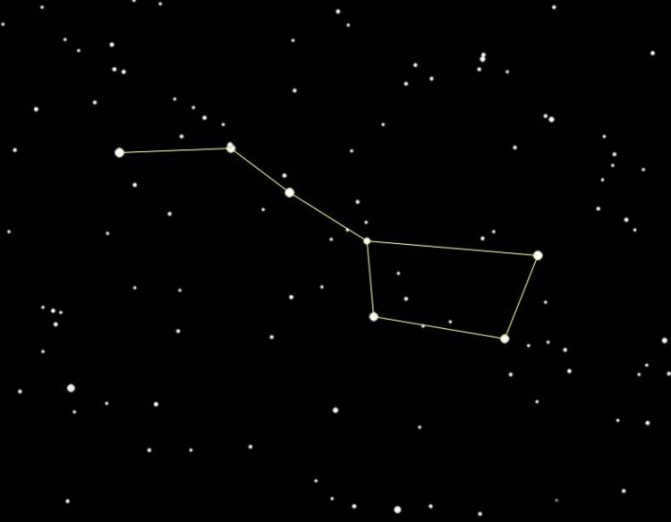
Ascendant
The constellation Ascendant can be found in the near-polar region of the sky in the northern hemisphere. Its most prominent star is Capella, a yellow double star that translates to “goat” or “goat star” in Latin. Capella is the sixth brightest star in the night sky and shines with a luminosity 170 times greater than that of the Sun. It is located approximately 13 parsecs away from us. Capella is actually a system of six stars, but unfortunately, it is not possible to observe them individually even with high-quality binoculars.
Volopassus is a stunning constellation located in the northern hemisphere of the sky. It captivates observers with its distinct arrangement, which resembles a parachute filled with air. In this depiction, the parachutist is none other than Arcturus, the third brightest star in the heavens. The name of this star is derived from the Greek words “arctos” meaning guardian and “ursus” meaning bear, thus signifying its role as the “guardian of the bear” in relation to the Big Dipper constellation.
Veronica’s locks
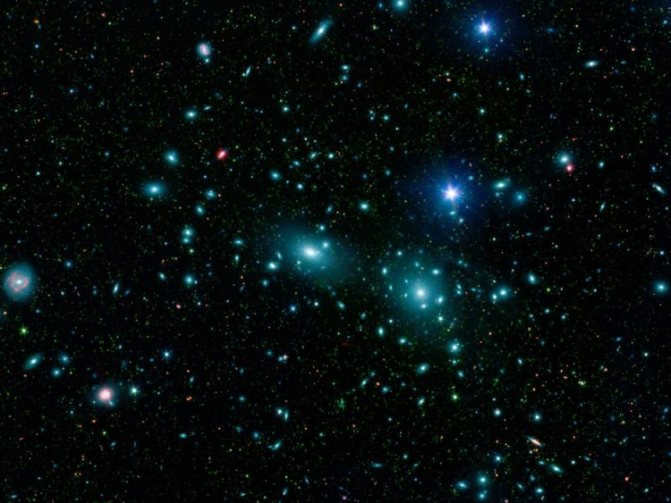
The constellation known as Veronica’s Hair can be found in the sky of the northern hemisphere. It consists of approximately 60 stars that can be seen without the aid of a telescope. Among these stars, the brightest one is Veronica’s Hair, which has a magnitude of 4.3″. This star is particularly interesting because it closely resembles the Sun in terms of its characteristics. In fact, if you were to observe Veronica’s Hair, you would get a sense of what the Sun would look like from a distance of 27 light years.
Hercules is a constellation that stands out in the northern hemisphere due to its size. On a night without a moon, it is possible to see around 140 stars with the naked eye, with the brightest ones belonging to the third magnitude. By mentally connecting these stars with lines, a distinct geometric figure of two large trapezoids with a shared base can be formed, representing the constellation of Hercules.
Dog Hunting Breeds
Dog Hunting Breeds is a constellation consisting of a small group of stars in the northern hemisphere of the sky, showcasing approximately thirty stars that can be seen with the naked eye. The most brilliant star in the Dog Hunting Breeds constellation was given the name by Edmund Halley, an English astronomer, to pay tribute to King Charles II, who played a significant role in the restoration of royal authority in England during the 17th century. This particular star is a stunning binary star, with one component shining in a golden yellow shade (3.2), while the other component has a purple hue (5.7), positioned at a distance of 20 angular seconds from the first component. To have the best view of this pair, it is recommended to observe it with binoculars or a small telescope.
Dragon
A mythical creature that appears in various cultures around the world, the dragon is often depicted as a large, serpent-like creature with wings and the ability to breathe fire. In many legends and stories, dragons are seen as powerful and fearsome beasts, capable of causing destruction and chaos. However, they are also sometimes portrayed as wise and benevolent creatures, capable of bringing good fortune and protection. The image of the dragon has been used in various forms of art and literature throughout history, and it continues to captivate the imagination of people today. From fantasy novels and movies to tattoos and artwork, the dragon remains a popular and iconic symbol.
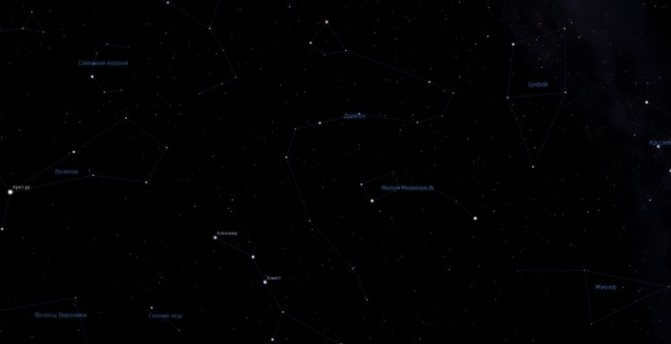
Dragon is a constellation located near the poles in the northern hemisphere of the sky. It is known for its vast size, covering a large area. There are over 200 stars within this constellation that can be observed with the naked eye, with 80 of them being brighter than a magnitude of 6t. One notable star is Tuban, also known as “The Snake,” which held the position of the northern polar star from 3700 to 1500 B.C. The brightest star in Dragon is Etamin, with a magnitude of 2.2. In Arabic, al-Ras al-Tinnin translates to “the head of the Dragon.” Another intriguing star within this constellation is Quma, which is an optical double, with its two components clearly visible when observed with binoculars.
Cassiopeia is a constellation located in the northern hemisphere of the sky that does not set. It contains approximately 90 stars that are brighter than 6 and can be seen without the aid of a telescope. Among the brightest stars in Cassiopeia are Rukbach, Rukba, Navi, Shedar, and Kaf. These stars form a distinct “W” shape that is used by navigators to determine their position at sea. One particularly interesting star in Cassiopeia is Navi, which exhibits variable brightness, resembling a new star that flares up and then fades. Its brightness ranges from 1.6 to 3. Another variable star in Cassiopeia, known as Cassiopeia’s variable ro, changes in brightness from 4 to 6.2, eventually becoming too faint to be seen with the naked eye. This star is a supergiant, weighing 40 times more than the Sun and shining approximately 500,000 times brighter.
Constellation of Swan
The constellation of Swan is located in the northern hemisphere of the sky. It is characterized by a distinct cross shape, known as the “Northern Cross,” which stretches across the Milky Way. This formation was interpreted by ancient civilizations as a flying bird, with the Babylonians referring to it as a “forest bird” and the Arabs calling it a “chicken.” One of the prominent stars in this constellation is Deneb, often referred to as the “chicken tail.” It is an incredibly bright star, classified as a blue supergiant, and has a luminosity that is 67,000 times greater than that of the Sun. Deneb is positioned at the upper left corner of the “Summer Triangle,” another notable celestial formation. Additionally, within the constellation of Swan is the beautiful Albireo, which is part of a double star system. This stunning duo can be easily observed using a small telescope.
Ursa Minor
Ursa Minor is a constellation that can be found in the northern hemisphere, close to the North Pole. It is made up of approximately forty stars that are visible to the naked eye. Currently, the North Pole is located less than 1° away from Polaris, which is also known as the North Star. Ursa Minor is often referred to as the Little Dipper, due to its seven stars that resemble a small bucket. The brightest star in the “handle” of the bucket is Polaris (alpha Ursa Minor), which has a magnitude of 2.0. The next brightest star is Kochab (beta Ursa Minor), with a magnitude of 2.1. From around 2000 B.C. to 500 A.D., Kochab served as the pole star and was known as Kochab-zl-Shemali, which translates to “Star of the North” in Arabic.
The Smallest Constellation in the Northern Hemisphere: Lesser Horse
Lesser Horse, the smallest constellation in the northern hemisphere of the sky, is known for its limited number of stars that can be seen with the naked eye on a clear night. With no more than ten visible stars, this constellation lacks a distinct geometric shape that would capture the attention of observers. Among these faint stars, the alpha star, also known as Kitalpha or al Kitah al Faras in Arabic, stands out. Its brightness is measured at 3.9 star magnitude. The remaining stars in Lesser Horse have a brightness that does not exceed 4.5 and lack proper names.
The constellation Orion
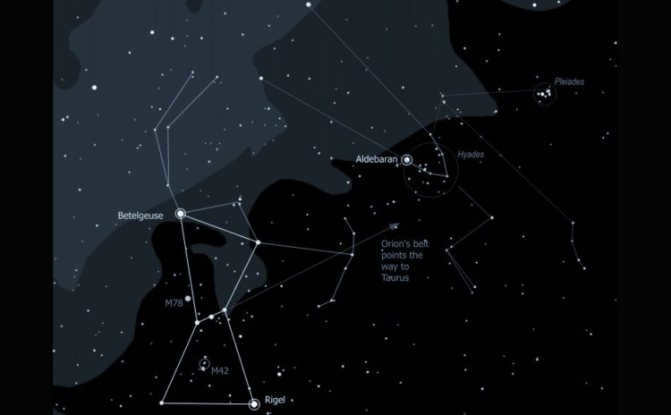
Orion is a well-known equatorial constellation found in the northern hemisphere. It is characterized by its unique pattern of stars. The star Betelgeuse, also known as alpha Orion, derives its name from the Arabic word for “armpit”. This star is classified as a red supergiant and is known for its irregular variations in luminosity, which can range from 0.2 to 1.2. Betelgeuse is located approximately 520 light-years away from Earth and has a luminosity that is 14,000 times greater than that of the Sun. It is considered to be one of the largest stars that astronomers have discovered, surpassing even the size of our own Sun. In fact, if Betelgeuse were to replace the Sun in our solar system, it would extend as far as the orbit of Jupiter. The volume of Betelgeuse is estimated to be 160 million times larger than that of the Sun.
Pegasus is a spacious equatorial constellation located in the southwest of Andromeda. It consists of over 1500 stars that can be seen with the naked eye. The most prominent ones are Enif, which shines with a magnitude of 2.5, and Markab (alpha Pegasus), which has a magnitude of 2.6. The relatively bright star Sheat (beta Pegasus) is a quadrilateral variable star, with its magnitude fluctuating randomly between 2.4 and 2.8. In Arabic, the names of the brightest stars in the constellation have the following meanings: Markab for “saddle” or “wagon”, Sheat for “shoulder”, Algenib for “horse’s navel”, and Enif for “nose”.
Perseus
The constellation Perseus is located in the northern hemisphere sky and has a unique shape that resembles an open circlet. Mirfak, the brightest star in Perseus, gets its name from the Arabic word for “elbow”. This massive giant star is located 590 light years away and has a magnitude of 1.8, making it 62 times larger than the Sun and 5000 times brighter.
Arrow
Arrow is a constellation located in the northern hemisphere that is both small and visually appealing. It consists of approximately thirty stars that can be seen without the aid of a telescope. Despite lacking any particularly bright stars, there is one star within Arrow that goes by the name Sham. Notably, the constellation is home to the variable star FG of Arrows, which has become the namesake for its own category of variable stars. Over the course of 100 years, this star has undergone significant changes in its temperature, ranging from 50,000 to 4,600 degrees Kelvin, as well as alterations in its atmospheric chemistry. Additionally, the FG Arrow star emits vast quantities of carbon dust and its outer layer is expanding.
Triangle
The constellation known as Triangle is a stunning yet relatively compact collection of stars located in the northern hemisphere. There are approximately twenty stars within this constellation that possess a star magnitude greater than 6. When observed without the aid of a telescope, Triangle appears in the form of a right-angled triangle situated below Andromeda. Positioned at the peak of this triangle is the star known as Metallach (alpha), which derives its name from the Arabic term meaning “apex of the triangle”. The most luminous star within Triangle is beta, boasting a brilliance rating of 3.
Cepheus
Cepheus is a constellation located in the northern hemisphere of the sky. Its unique shape resembles an irregular pentagon. The southern region of Cepheus overlaps with the Milky Way. This constellation is home to approximately 150 stars that can be seen with the naked eye. Unlike other constellations, Cepheus does not have any particularly bright stars, with the brightest one being Alderamin (also known as alpha Cepheus) which has a magnitude of 2.4. Another notable star in Cepheus is Delta Cepheus, which is a double star. It has a luminosity range of 3.7 to 4.5 and completes one cycle in 5.4 days. Delta Cepheus was first discovered by the English amateur astronomer John Goodricke in 1784.
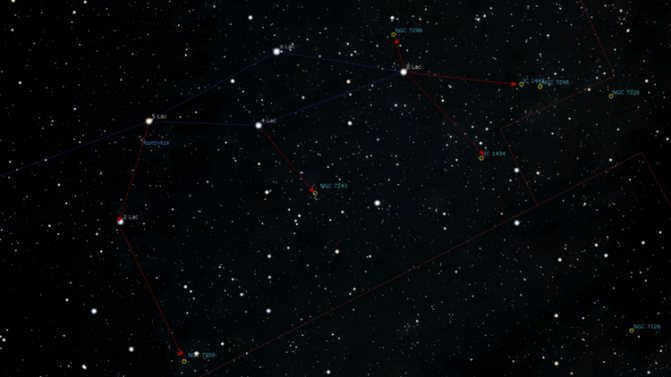
The Lizard is a compact constellation located along the Milky Way. Its dim stars do not form any distinct geometric pattern. On a cloudless evening, approximately thirty stars can be spotted with the naked eye within this constellation. However, only one of these stars possesses a brightness level of 3.8, making it necessary to view the entire constellation under optimal conditions, such as a moonless night with excellent visibility, in order to fully appreciate its beauty.
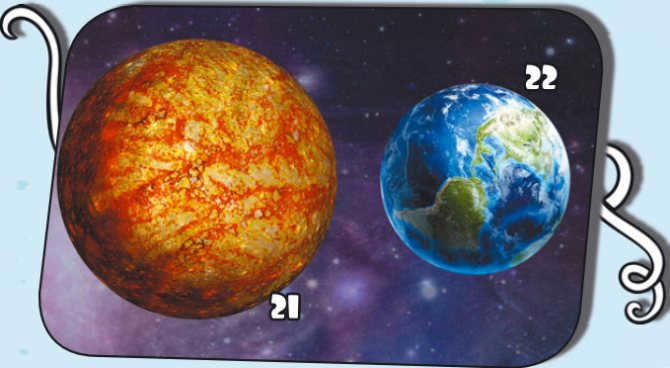

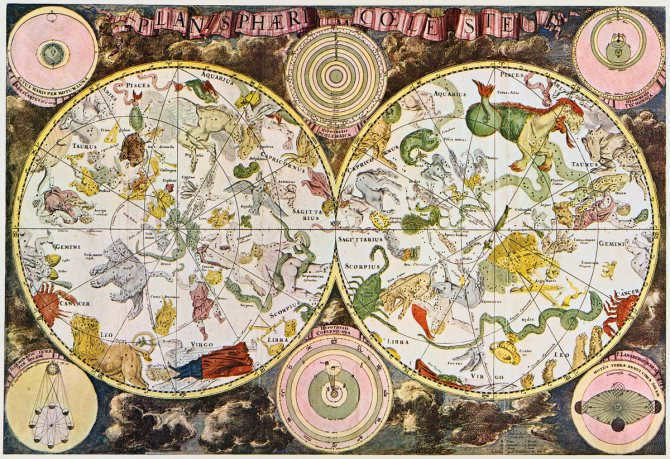
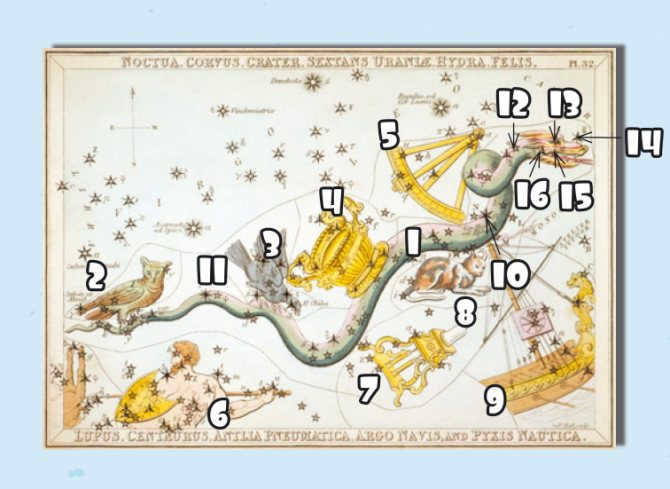
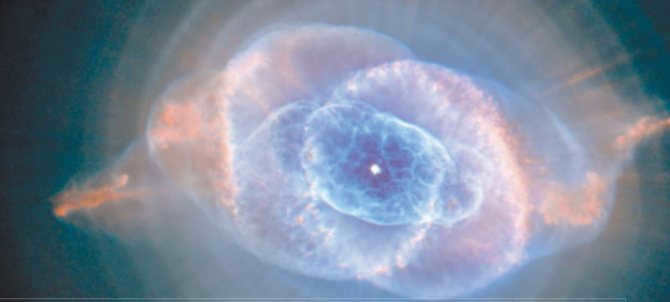
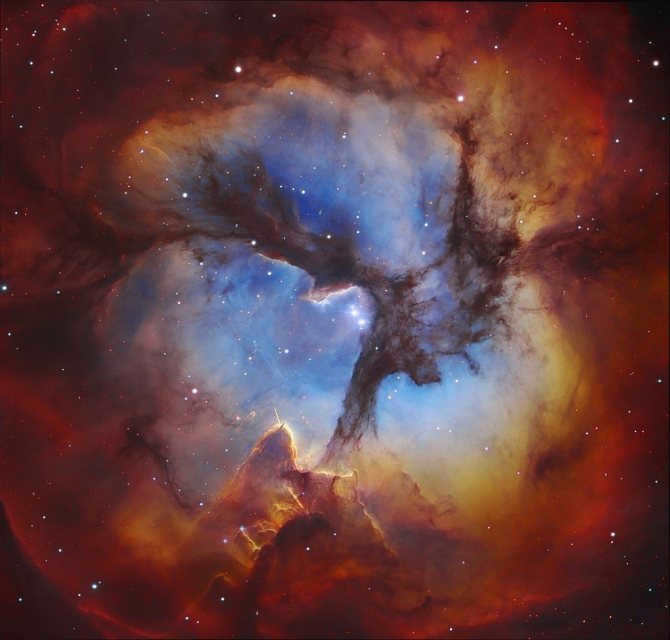

When you find yourself in the southern part of the world, you can use the constellation Southern Cross to help you navigate. Unlike the well-known Polaris, which is not visible in this hemisphere, Southern Cross can serve as a reliable guide.
Consisting of four prominent celestial lights, the Southern Cross is distinct and easily recognizable. It is crucial, however, to differentiate it from the False Cross, which is situated to the right. The stars in the False Cross are not as bright and are more spread out.
To determine the southern direction, mentally draw a line connecting two stars that are directly across from each other. This will form two intersecting rays, with the longer one pointing towards the south.
Please take note! In case the traveler has some free time, it is advisable to wait for the instance when the fictional elongated queue in the constellation shifts to a perpendicular orientation with respect to the celestial sphere. At that point, the correct path towards the south can be determined by merely observing the Southern Cross.
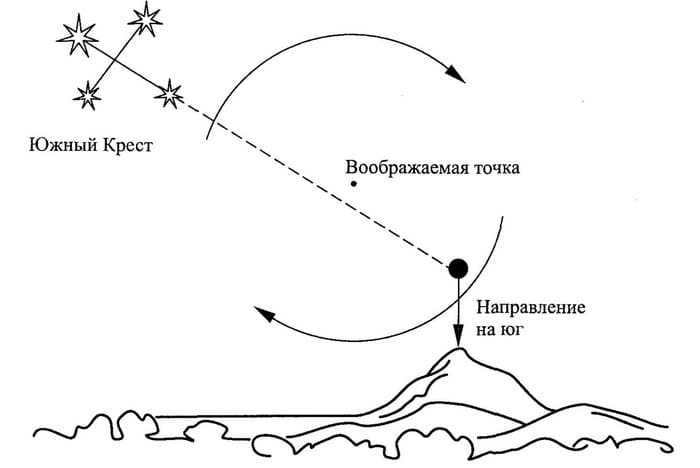
Orienteering using the Southern Cross
Orienteering using the constellation Orion
The constellation Orion is visible from any location on Earth, making it a useful tool for determining direction in both the northern and southern hemispheres. However, this method is only effective during the winter season.
Orion is composed of seven stars and has the shape of an hourglass. In the center, three stars form what is known as Orion’s Belt. During sunrise, the rightmost point of the Belt indicates the east, while at sunset it indicates the west.
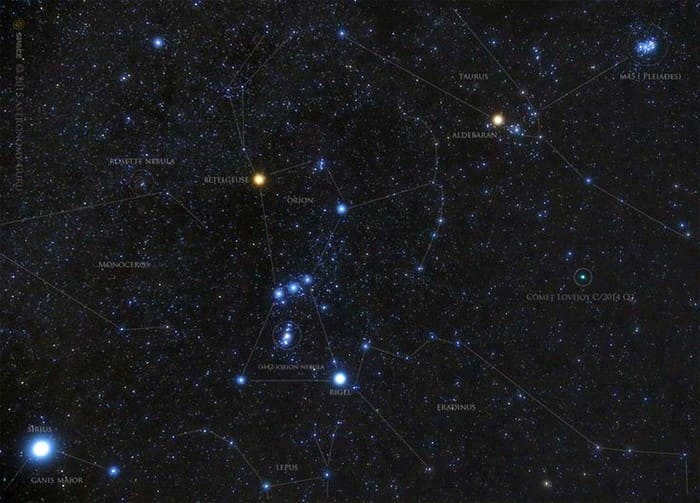
The Orion constellation
Citations
- Kondratyev N.Y. “Aviation Astronomy” 1950
- Flight Simulator 2004: A Century of Flight Real Stars mod Realistic display of stars in FS2004.
- MyFsStars 1.0 – Stars and constellations for Flight Simulator 2004 (FS2004, FS9) Realistic display of stars in FS2004.
- Stars and constellations for Flight Simulator 2004 Surrealistic (with constellation drawings) display of stars in FS2004.
- Methodical instructions for laboratory works on navigational astronomy Panasenko A.N.
- History of names of navigational stars
Latitude Determination
Thanks to celestial bodies, experienced travelers have the ability to determine the latitude of their current location even during nighttime. To accomplish this, the following steps must be taken:
- Locate Polaris.
- One can utilize any method of locating Polaris by observing the constellations of Ursa Major or Cassiopeia.
- Measure the angle between Polaris and the horizon.
In this scenario, there are two possible options:
- To precisely determine the number of degrees in this angle, it is advisable to use specialized instruments. By using a quadrant and a sextant, one can determine the angle displayed on the curved surface of the instrument. The resulting angle corresponds to the latitude north of the equator.
- It is possible to roughly determine the angle without the use of navigation devices. Simply extend your arm towards the horizon and slowly stack one fist on top of the other. Repeat this process until you reach the North Star. Each outstretched fist represents approximately 10 degrees.
Constellation Placement
If a traveler possesses knowledge of constellations, they can effectively determine cardinal directions and navigate accurately, especially when the sky is clear. Consequently, it is crucial for novices to grasp the manner in which stars shift their position both throughout the course of a single night and over the span of a calendar year. Specific times of the year are more conducive for identifying certain constellations.
| Time of year | Month | Constellations |
| Spring | March | Cancer, Kiel, Compass, Leo, Flying Fish, Lynx |
| April | Great Bear, Chameleon, Bowl, Hydra, Lesser Lion | |
| May | Southern Cross, Hound Dogs, Centaurus, Virgo, Magus, Magpie | |
| Summer | June | Little Bear, Libra, Wolf |
| July | Northern Crown, Dragon, Hercules, Scorpio, Southern Triangle, Snake, Serpent, Serpentine. | |
| August | Southern Crown, Lyra, Sagittarius, Shield, Telescope | |
| Autumn | September | Eagle, Capricorn, Swan, Dolphin, Lesser Horse, Indian |
| October | Aquarius, Cepheus, Crane, Pegasus, Southern Fish | |
| November | Cassiopeia, Andromeda, Phoenix, Pisces, Tucana, Taurus. | |
| Winter | December | Orion, Aries, Eridanus, Furnace, Clock, Southern Hydra, Perseus, Triangle |
| January | Small Dog, Goldfish, Table Mountain | |
| February | Big Dog, Ascendant, Giraffe, Dove, Gemini, Hare, Painter, Unicorn. |
The Pegs Universal Approach
Daytime Orienteering
Daytime orienteering can also be accomplished using the Sun. It serves as a reliable reference point that maintains a consistent trajectory throughout the day. Additionally, unfavorable weather conditions rarely hinder visibility of this celestial body.
There are two fundamental principles of orienteering that rely on the Sun’s position. Firstly, in the southern hemisphere, a traveler can determine their northward direction by observing the Sun at noon. Conversely, in the northern hemisphere, one can establish their southward direction during this time. Secondly, the Sun always rises in the east and sets in the west.
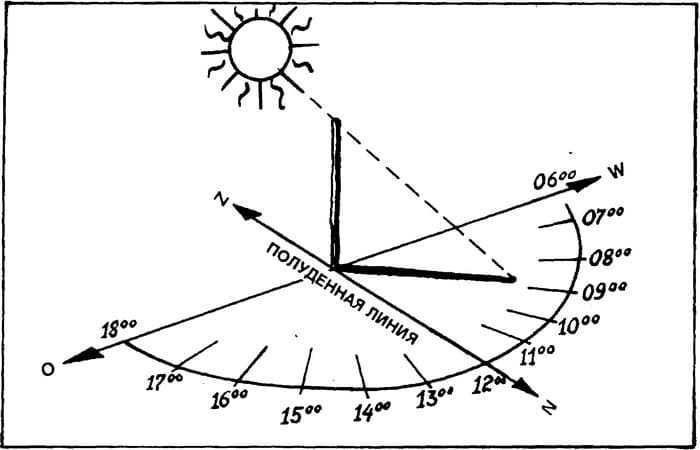
Peg orienteering
Peg orienteering can be done in the following way:
- Start by driving a long stake or peg into the ground, preferably on a level surface, so that a clear shadow is formed.
- Then mark the top of the shadow cast by the object.
- Wait for at least 30 minutes and mark the new position of the shadow.
- Connect the two marks to determine the east-west direction. The first mark will indicate the west, while the second mark will indicate the east.
- To determine the location of the north, one must face a specific line and place the toe of the left foot on the first mark, while the right foot should be positioned on the second mark. The north is in front, with the north-south direction perpendicular to the line.
Navigation during overcast sky conditions
Occasionally, weather conditions make it challenging to navigate using the Sun, particularly when it is obscured by thick, dark clouds. However, it is still possible to ascertain the direction of travel if the remaining parts of the sky are comparatively less cloudy. Keep in mind that calculations may have an error margin of 10-20 degrees.
In overcast weather, the methods involving pegs can still be utilized without any issues, as the clouds do not obstruct the observation of the Sun’s shadow. In such scenarios, some adventurers opt for an alternative method of orienting themselves using the Sun, which is as follows:
- The morning also serves as the reference point for measuring the length of the shadow from the peg.
- Once it is past noon, a second marking of the top must be made when the shadow reaches the same length as it did during the first marking.
- These two points are then connected by a straight line, which serves as the north-south indicator.
Nighttime Orienteering
If a traveler finds themselves lost in the wilderness, they can devise a new course of action regardless of their location on the globe. For instance, the constellation Orion, which is visible in both the northern and southern hemispheres, can serve as a guide. However, if one prefers, they can select any other star to implement this universal technique.

Orienteering using pegs at night
What is this method of orienteering:
- First, pegs are placed at intervals of 1 meter from each other. The chosen celestial object should be aligned with the pegs.
- Next, observe the movement of the star for a period of time.
- If the star rises above the imaginary line between the pegs, it indicates that the line points east. Conversely, if the star moves slightly downward, it means the line points west.
- Movement to the right indicates the southern direction, while deviation to the left indicates the northern direction.
Constellations in the Subpolar Region of the North
Similar to the Moon, the constellations move across the night sky in an east-west direction. This occurs because the Earth rotates on its axis from west to east. The constellations that lie within 40 degrees of the North Pole are categorized as part of the North Subpolar Region. These constellations are always visible throughout the year and never disappear below the horizon. The North Subpolar Region consists of five major circumpolar constellations: Cassiopeia, Cepheus, the Big Dipper, the Little Dipper, and the Dragon. The Dragon constellation is a collection of stars that spans across a large portion of the sky. Its tail can be found between Polaris and the Big Dipper, its body wraps around the Little Dipper and Cepheus, and its head points towards the Hercules constellation.
Triangle of Stars in the Summer Sky of the Northern Hemisphere
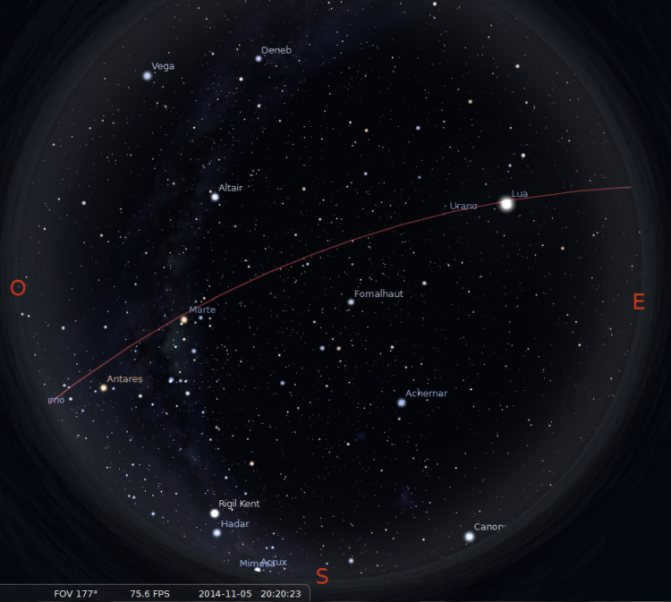
During warm summer nights in the Northern Hemisphere, stargazers are treated to the beautiful sight of the Summer Triangle. This celestial formation is comprised of three of the most brilliant stars in the constellations of Lyra, Swan, and Eagle: Vega, Deneb, and Altair.
Winter star triangle in the Northern Hemisphere
During the winter season, the midnight sky showcases the Winter Triangle, which consists of the brightest stars in Orion (Betelgeuse), the Big Dog (Sirius), and the Lesser Dog (Procyon).
Other constellations such as Leo and Virgo also possess prominent stars and are best observed in the spring. Some constellations that are not part of the circumpolar region may be partially hidden below the horizon, but can still be partially seen in the southern hemisphere. These include Orion, Taurus, the Big Dog, and Gemini.
Using Stars as a Navigation Tool at Sea
Utilizing the position of stars as a sole means of finding the correct path while out at sea is an exceedingly difficult task. Nowadays, modern ships, as well as smaller boats, are equipped with satellite navigation systems that function even in the most remote locations far from land.
Explorations and expeditions across the world were accomplished long before the advent of satellites and computers. Renowned explorers and famous travelers charted precise courses utilizing natural indicators. In earlier times, the stars, sun, moon, wind direction, and ocean currents served as the primary aids for orienting oneself on the vast open sea.
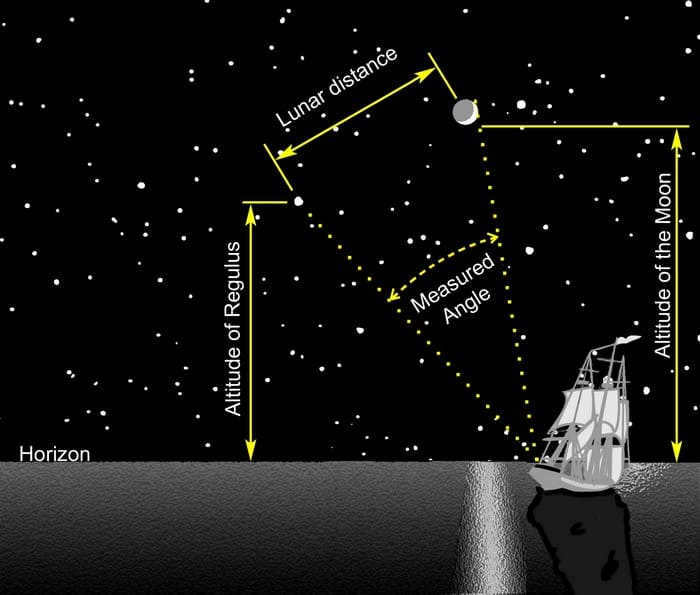
Orienteering by stars in the ocean
Also worth reading: Guide to staying safe in the woods for students and pupils of MBOU School № 36
It wasn’t just scientists who explored the seas. The Vikings traveled the world, relying not only on calculations for navigation, but also on their intuition and incredible attention to detail.
Just so you know! Sailors in ancient times also used sundials as a way to navigate. This allowed them to estimate the speed of their ship and find their way to land even in cloudy weather. However, these calculations were not very accurate.
Nowadays, ship GPS systems have become highly reliable, yet they are still vulnerable to cyber attacks. As a result, it is crucial for every sailor to be acquainted with celestial navigation techniques. Depending on the hemisphere, one can utilize the stars such as Polaris or the Southern Cross constellation to determine the cardinal directions while at sea.
Having this skill can prove invaluable in various situations. It is worth noting that these methods, without the aid of specialized instruments, do have a margin of error. However, if a tourist ever finds themselves lost, the ability to navigate by the stars will prevent panic, enable them to find the correct course, and ultimately escape from unfamiliar territory.
Did you find this information helpful? Feel free to share your thoughts in the comments!
Boundaries of contemporary constellations
The creation of an atlas and catalog of the southern sky, known as Argentine Uranometria, was a collaborative effort led by the American astronomer Benjamin Antorp Gould (1824 – 1896) and his colleagues at the National Observatory in Cordoba, Argentina. The final volume of this work was published in 1879.
Gould’s approach to defining the boundaries of constellations was innovative. While he adopted the constellation list and structure from Argelander’s star atlas, he introduced a unique feature. Using fragments of his atlas’s map grid, Gould created clear and simple distinctions for the southern constellations. He drew inspiration from the boundaries between individual states in his own country, which often align with the earth’s parallels and meridians.
Gould’s star chart of the southern sky appears to be unique in its design. Rather than including figures of the constellations, the chart solely displays the stars themselves, along with their boundaries and Latin names. The constellations are delineated by concentric arcs centered on the south pole and “rays” extending from it, gradually blending with the more nuanced divisions of Argelander.
This method of demarcation was later expanded to encompass all constellations during the early 1900s.
The boundaries established by the ICA in 1928 and the Latin names and abbreviations of the constellations, which were determined in 1922, have become the global standard. The Ptolemaic constellations were supplemented by the 12 constellations of the southern sky, which were divided by Keyser in 1595, the 3 constellations of Plancius (1598), the 7 constellations of Hevelius (1690), and the 14 southern constellations mapped by Lacaille in 1752. The process of dividing the sky into constellations appears to have been finalized. It is unlikely that there will be any reason to reconsider the decisions made in 1922 and 1928 in the near future, but their cultural history lives on. Alongside the interest in astronomy, there is a growing fascination with the starry sky as a part of the natural world that surrounds us and as a significant and inspiring aspect of the mythological space of ancient traditions. Its aesthetic and cognitive importance is increasingly being acknowledged in the modern era.
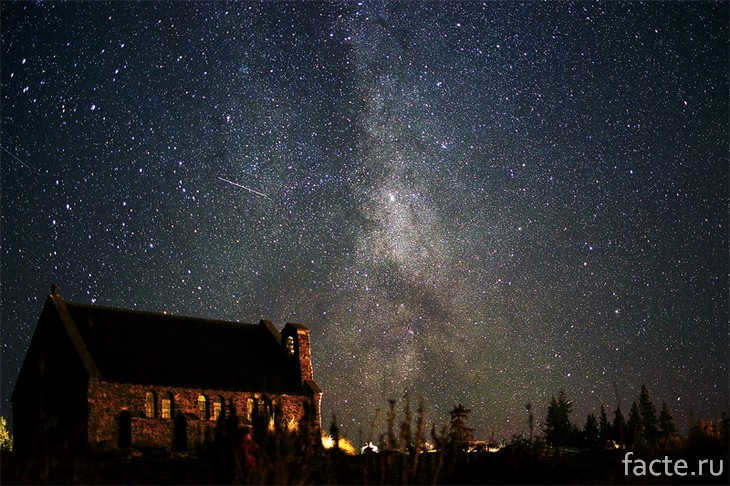
The celestial canopy is filled with a plethora of twinkling stars, shooting comets, and awe-inspiring natural occurrences like the Aurora Borealis and the luminous Milky Way. Capturing the perfect snapshot of constellations relies heavily on the specific vantage point, the season, and even the nocturnal rhythm.
In the vicinity of Lake Tekapo, New Zealand
This location offers a stunning view of the majestic Milky Way. Moreover, during the mid-1900s, an observatory was constructed in this area specifically for the purpose of studying celestial bodies. Interestingly, the nearby cities have implemented a unique lighting system, with street lamps designed to direct the light downwards and turn off earlier than usual.

Block: 2/11 Columns of characters: 286
Source: https://facte.ru/nature/zvezdnoe-nebo-iz-kakih-ugolkov-planet
Does night time vary around the world?
Throughout the year, the Earth’s axis undergoes changes, causing the Sun’s rays to illuminate different parts of the globe. This leads to the occurrence of different seasons. While Russia experiences winter, the North Pole is in a state of polar night, and Antarctica remains constantly bathed in light. The duration of the night varies depending on the geographic latitude and the angle at which the Sun’s rays hit the Earth’s surface.
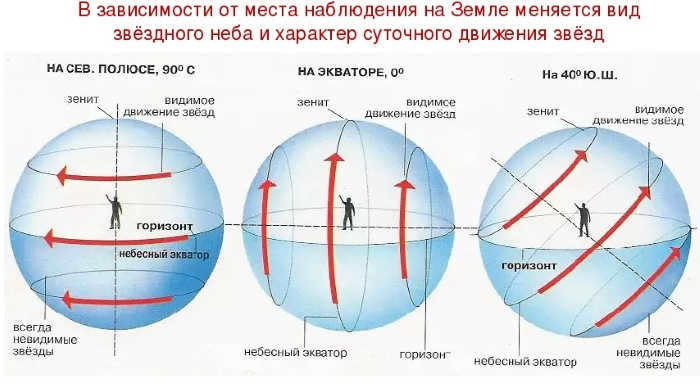
Therefore, at the equator, the length of the night is the same as the length of the day, which is 12 hours. This is because the horizon divides the path of the Sun in half during the day. In comparison to the temperate latitudes of the Earth, this duration is longer than the winter night but shorter than the summer night.
There is also a phenomenon known as polar night, where the Sun does not shine on the Earth for more than 24 hours. This is a natural anomaly that occurs in certain cities:
- Vorkuta;
- Norilsk;
- Murmansk;
- Severomorsk;
- Apatity;
- Monchegorsk.
The reason behind this event is the Earth’s axis tilt in relation to the plane of its orbit around the Sun. In the polar regions, during the winter season, the sky remains just below the horizon line, resulting in a prolonged twilight period instead of complete darkness.
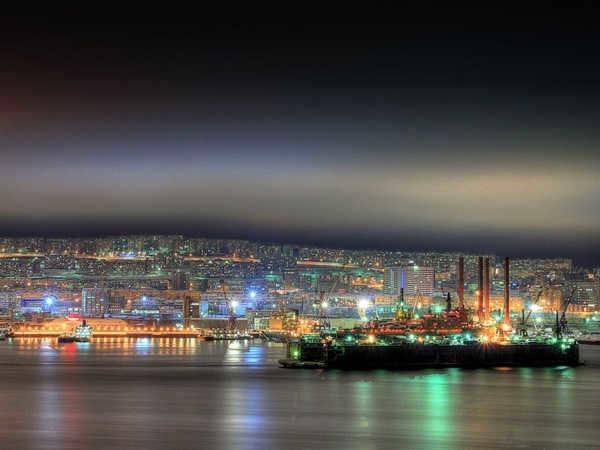
The picture depicts the night sky above Polyarny, a town in the Murmansk region, during the polar night.
There are various types of polar nights, varying in terms of darkness:
The duration of the polar night depends on the proximity of the settlement to the Arctic Circle:
| Settlement | Duration of polar night, in days |
| Norilsk | 45 |
| Vorkuta | 10 |
| Apatity | 13 |
| Murmansk | 39 |
| Dudinka | 43 |
Pic du Midi Mountain, Pyrenees
The tranquility of this place is absolutely serene, providing the perfect opportunity to capture breathtaking images of the celestial sphere. Visitors are captivated by the sheer magnificence that unfolds before their eyes.
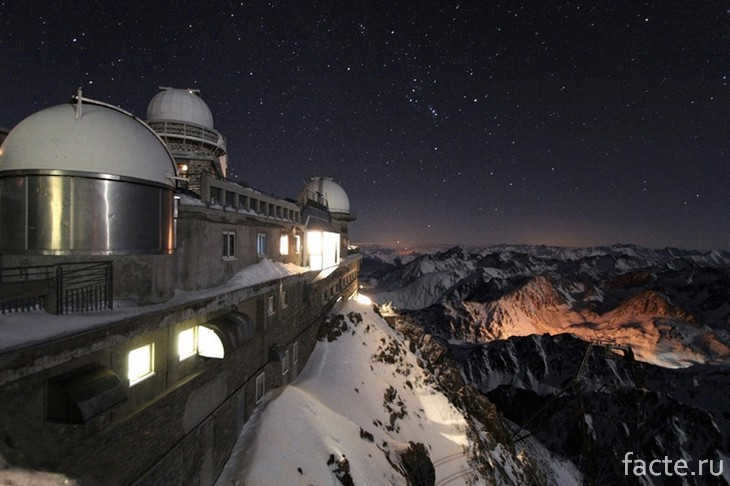
Block: 3/11 Character count: 164
Source: https://facte.ru/nature/zvezdnoe-nebo-iz-kakih-ugolkov-planet
Constellations visible at various latitudes
The appearance of the night sky, captured in the photo with numerous constellations, differs depending on the specific location on the planet. This phenomenon is influenced by a person’s geographical latitude.
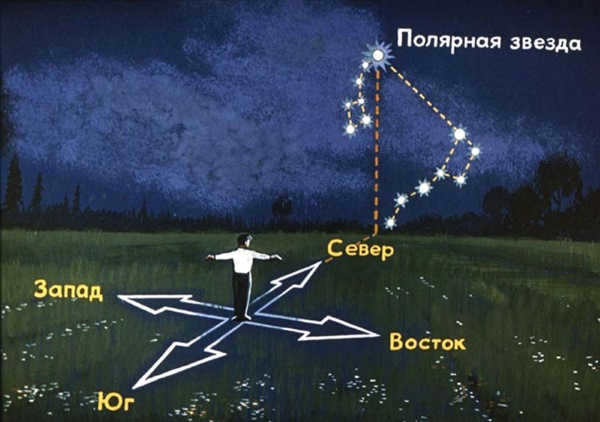
As you travel from Moscow to the North Pole, the height of the sky gradually increases. At the North Pole, the angle of elevation reaches 90˚, placing the sky directly above the observer. The arrangement of stars and the appearance of the night sky at the pole are completely distinct from those in Moscow.
In relation to the pole, the celestial equator aligns with the horizon, causing the stars to move along it. In the northern portion of the sky, all stars remain above the horizon, as there are no rising or setting stars at the North Pole.
At the Earth’s equator, the starry sky exhibits a different appearance. The star Polaris appears lower in the sky and approaches the horizon. The motion of the stars in this region causes each star to be visible for half of the day below the horizon and the other half above it.
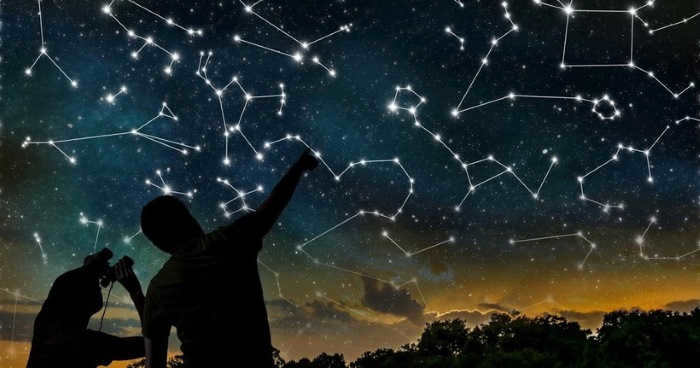
The night sky is filled with a multitude of stars, which have been grouped into various constellations with names dating back to ancient times. Among these constellations are Orion, Andromeda, Perseus, Taurus, Whale, and many others. In total, there are 88 constellations, with the Big Dipper being the largest and most well-known.
Each constellation contains stars that vary in brightness, with some being bright and easily visible to the naked eye, while others are faint and require more effort to see.
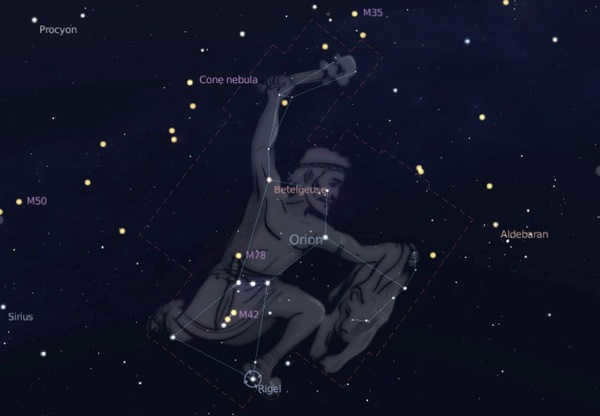
- Orion – The most impressive constellation in the southern sky. Its three-star belt acts as the dividing line between the northern and southern hemispheres. The stars of Orion are of the second magnitude, and the constellation’s nebula (a bright luminous spot) is easily visible in clear air.
- Virgo. The constellation Virgo, which resembles a quadrilateral, is adorned with the dazzling first magnitude star Spica. This star shines brightly over the southern horizon and can be seen without the need for a telescope.
- The Raven and the Cup. South-east of Virgo lies the constellation Raven, forming a quadrilateral shape. To the west is the Bowl, consisting of stars with a magnitude of six.
- Libra. In the south-eastern sky, you can find the constellation Libra, which has three prominent peaks. Kiffa, a star of first magnitude, is also part of this constellation.
In the west, Orion passes through the constellation Taurus. This is also where the Lesser Dog emerges from the surface of the Earth.
- Lyra. The most notable star, Vega, forms a quadrilateral shape with three faint stars at the corners. Vega is the most prominent star in the northern sky.
- Dolphin, Foxy, Arrow, Shield. The Dolphin constellation is situated in the east. Nearby are the Arrow and Foxy constellations, and with the help of instruments, one can observe a nebula in the latter. The Milky Way traverses through all of these star clusters, including the Shield.
- Sagittarius. The Sagittarius constellation is easily recognizable in the southern region. Ancient civilizations associated it with a centaur and depicted it as a half-man. This collection of stars is challenging to observe in the central and northern latitudes, just like the Milky Way.
NamibRand Reserve in Namibia: A Unique and Remote Sanctuary
Immerse yourself in the unspoiled beauty of NamibRand Reserve, a true protected sanctuary situated 97 kilometers away from the nearest settlement. This remote location ensures that no artificial light will hinder your ability to fully appreciate and marvel at the mesmerizing night sky.

Block: 4/11 Character count: 194
Source: https://facte.ru/nature/zvezdnoe-nebo-iz-kakih-ugolkov-planet
How the Stars’ Appearance Depends on the Time of Year
The night sky (which cannot be fully captured in a photo) undergoes changes in its appearance based on both geographical latitude and time. Each season, the constellations take turns appearing in the sky.
In winter, particularly in January, the cold air, early dusk, and clear skies provide the opportunity to observe countless stars with the naked eye. The constellations move across the celestial equator and are positioned at their highest point in the sky.
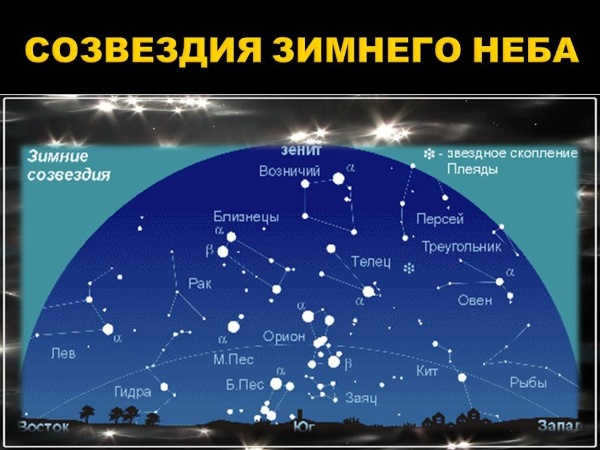
Winter star formations:
- Gemini;
- Taurus;
- Perseus;
- Aries;
- Pisces;
- Little Dog;
- Hydra;
- Leo.
Spring stellar clusters are visible for a limited time of 2 months (April and May). The duration of the day increases, causing the night to arrive later, resulting in the constellations “skipping” across the sky within a short timeframe.
As the year goes on, the brightness of the stars shifts: initially, a specific constellation can be seen in the morning, then in the evening, and finally during the night. Consequently, it becomes observable at an earlier time each night.
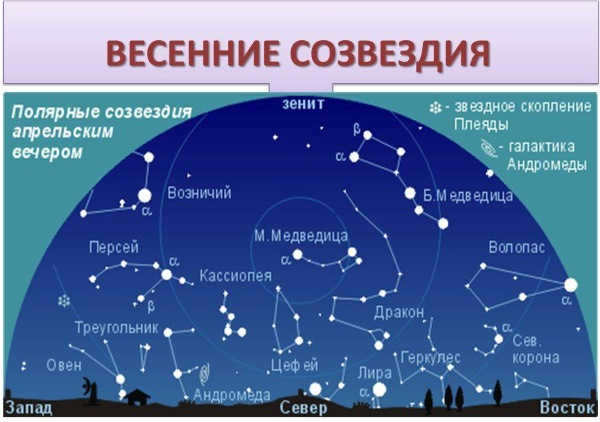
Constellations visible during the spring season:
- The Ursa Major;
- The Wizard;
- The Canes Venatici;
- The Serpens;
- The Corona Borealis;
- The Serpens Cauda.
In the summer and early autumn months, the stars can be seen particularly well outside of urban areas. The bright star Vega (in the constellation Lyra) is the first to rise, followed by Deneb (in the constellation Cygnus), and then Altair (in the constellation Aquila). The shimmering Milky Way can be faintly seen in the southern part of the sky, passing through the star clusters of Cygnus and Altair and extending towards Scorpius and Sagittarius.
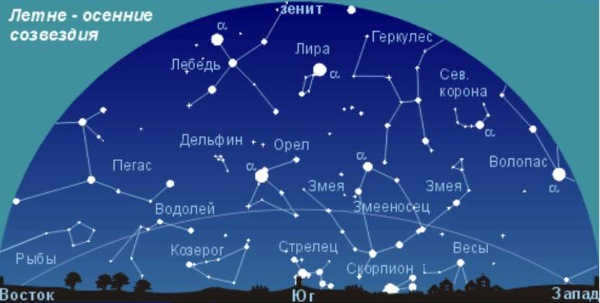
The Way’s band splits into two sections after the Swan constellation. Most of the stars in this celestial phenomenon are obscured by the Sagittarius constellation.
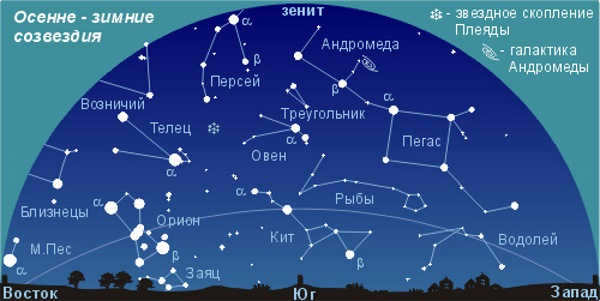
During the late autumn and early winter seasons, the constellations Andromeda, Perseus, and Pegasus dominate the sky. Positioned directly overhead is Cassiopeia, while Cepheus can be found to the northwest, forming a pentagon shape with its celestial bodies. Moving closer to the northern horizon, we can observe the Bucket of the Big Dipper.

